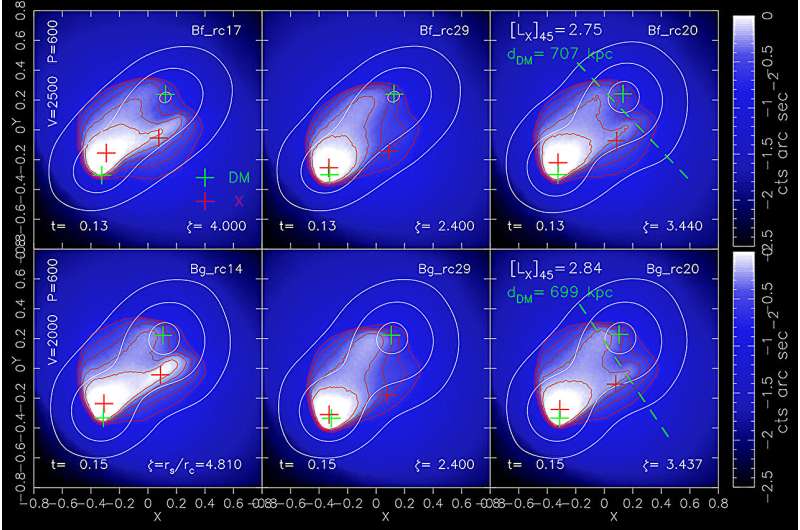
Credit: Astronomy and astrophysics (2024). DOI: 10.1051/0004-6361/202348000
Contrary to what is established by the standard model, dark matter could actually interact with itself. This is the conclusion of a study published in Astronomy and astrophysics and led by Riccardo Valdarnini of the SISSA Astrophysics and Cosmology Group. Using numerical simulations, the study analyzed what is happening inside “El Gordo” (literally “The Big One” in Spanish), a giant cluster merger located seven billion years ago. light of us.
Calculations indicated that in this cluster, the physical separation observed between the points of maximum density of dark matter and those of other mass components can be explained using the so-called SIDM (Self-Interacting dark Matter) model, as opposed to the standard. A. This research makes an important contribution to the SIDM model, according to which dark matter particles exchange energy during collisions, with interesting astrophysical repercussions.
“El Gordo”: a gigantic cosmic structure for the study of dark matter
“According to the currently accepted standard cosmological model, the current baryonic matter density of the universe can only represent 10% of its total matter content. The remaining 90% is in the form of dark matter,” explains Valdarnini, author of the ‘work. research.
“This matter is generally thought to be non-baryonic and made of cold, collisionless particles that respond only to gravity. Hence the name “cold dark matter” (CDM). However, there are still a number of observations that have not yet been studied. explained using the standard model,” explains the researcher. “To answer these questions, several authors propose an alternative model, called SIDM.”
Proving the collisional properties of dark matter and, more generally, alternative theories to that of the standard cosmological model, is very complicated. He explains: “There are, however, unique laboratories that can be very useful for this purpose, light years away. These are the massive clusters of galaxies, gigantic cosmic structures which, during a collision, determine the most energetic events since the Great Slam.
“With a mass of approximately 1015 solar masses, El Gordo is one of the largest galaxy clusters we know. Due to its particularities, El Gordo has been the subject of numerous studies, both theoretical and observational.
Dark matter could be collisional
According to the standard paradigm, during a cluster merger, the behavior of the collisional gas mass component will be different from that of the other two components: galaxies and dark matter. In this scenario, the gas will dissipate part of its initial energy.
“This is why, after the collision, the peak mass density of the gas will lag behind that of dark matter and galaxies,” explains Valdarnini. With the SIDM model, however, a particular phenomenon should be observed, namely the physical separation of dark matter centroids – its points of maximum density – from those of other mass components exhibiting peculiarities which represent a true “signature of the models SIDM”. According to observations, this is exactly what is happening inside “El Gordo”.
Observe El Gordo
“Let’s start with observations,” says Valdarnini. El Gordo consists of two massive subgroups, referred to as northwest (NW) and southeast (SE), respectively. The X-ray image of the “El Gordo” cluster shows a single X-ray emission peak in the SE subcluster and two faint elongated tails beyond the X-ray peak. A notable feature is the location of the peaks of the different mass components.
Unlike what can be observed in the Bullet Cluster, another important example of a colliding cluster, the X-ray peak precedes the SE dark matter peak. Additionally, the Brighter Galaxy (BCG) not only lags behind the X-ray peak, but also appears to be spatially offset from the SE center of gravity. Another notable aspect can be observed in the NW cluster, where the galaxy number density peak is spatially shifted from the corresponding mass peak.
The research results suggest that collisional dark matter could explain the phenomena observed in “El Gordo”.
To explain his findings and validate the SIDM models, Valdarnini used a large set of so-called N-body/hydrodynamic simulations. Thus, he conducted a systematic study aimed at reproducing the observational characteristics of “El Gordo”.
“The most significant result of this simulation study is that the relative separations observed between the different mass centroids of the cluster ‘El Gordo’ are naturally explained if dark matter interacts with itself,” says Valdarnini.
“For this reason, these results provide an unambiguous signature of dark matter behavior that exhibits collisional properties in a very energetic high-redshift cluster collision. There are inconsistencies, however, because the SIDM cross section values obtained from these simulations are greater than present upper limits, which are of order unity at the cluster scale.
“This suggests that current SIDM models should be considered only as a lower-order approximation and that the underlying physical processes that describe the interaction of dark matter in major cluster mergers are more complex than can be expected. be adequately represented by the commonly assumed approach based on the scattering of dark matter particles.
“The study convincingly argues for the possibility of dark matter self-interaction between colliding clusters as an alternative to the standard collisionless dark matter paradigm.”
More information:
R. Valdarnini, A hydrodynamic/N-body simulation study of the molten cluster El Gordo: a convincing argument for self-interactive dark matter?, Astronomy and astrophysics (2024). DOI: 10.1051/0004-6361/202348000
Provided by the International School for Advanced Studies (SISSA)
Quote: News from ‘El Gordo’: Study suggests dark matter might have collisional properties after all (May 31, 2024) retrieved May 31, 2024 from https://phys.org/news/2024-05-news-el -gordo-dark -collision.html
This document is subject to copyright. Apart from fair use for private study or research purposes, no part may be reproduced without written permission. The content is provided for information only.